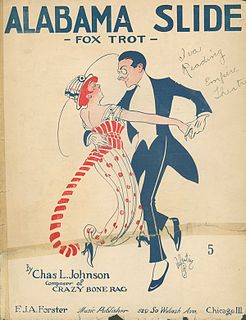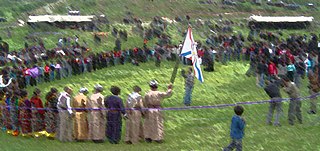In some types of partner dance, lead and follow are designations for the two dancers comprising a dance couple. In the case of mixed-sex couples, the male is traditionally the Lead and the female is the Follow. The Lead is responsible for guiding the couple and initiating transitions to different dance steps and, in improvised dances, for choosing the dance steps to perform. The Lead communicates choices to the Follow and directs the Follow by means of subtle physical and visual signals, thereby allowing the couple to be smoothly coordinated.

The jig is a form of lively folk dance in compound metre, as well as the accompanying dance tune. It developed in 16th-century England, and was quickly adopted on mainland Europe where it eventually became the final movement of the mature Baroque dance suite. Today it is most associated with Irish dance music, Scottish country dance and the Métis people in Canada. Jigs were originally in duple compound metre,, but have been adapted to a variety of time signatures, by which they are often classified into groups, including light jigs, slip jigs, single jigs, double jigs, and treble jigs. There is also the reel and waltz.

The Charleston is a dance named for the harbor city of Charleston, South Carolina. The rhythm was popularized in mainstream dance music in the United States by a 1923 tune called "The Charleston" by composer/pianist James P. Johnson which originated in the Broadway show Runnin' Wild and became one of the most popular hits of the decade. Runnin' Wild ran from 29 October 1923 through 28 June 1924. The peak year for the Charleston as a dance by the public was mid-1926 to 1927.
The Balboa is a swing dance that originated in Southern California during the 1920s and enjoyed huge popularity during the 1930s and 1940s. The term Balboa originally referred to a dance characterized by its close embrace and full body connection. It emphasizes rhythmic weight shifts and lead-follow partnership. Different dancers in the same region at the same time also danced "swing," a dance characterized by twists, turns, and open-position movement. Over time, these two dances merged and became collectively known as Balboa. The original Balboa dance is now referred to as Pure Balboa, and the original "Swing" dance is now referred to as Bal-Swing or L.A. Swing to differentiate it from other types of swing. Because of its emphasis on subtlety and partnering rather than flashy tricks, Balboa is considered more of a "dancer's dance" than a "spectator's dance."

The foxtrot is a smooth, progressive dance characterized by long, continuous flowing movements across the dance floor. It is danced to big band music. The dance is similar in its look to waltz, although the rhythm is in a 4
4 time signature instead of 3
4. Developed in the 1910s, the foxtrot reached its height of popularity in the 1930s and remains practiced today.
The schottische is a partnered country dance that apparently originated in Bohemia. It was popular in Victorian era ballrooms as a part of the Bohemian folk-dance craze and left its traces in folk music of countries such as Argentina, Finland ("jenkka"), France, Italy, Norway ("reinlender"), Portugal and Brazil, Spain (chotis), Sweden, Denmark ("schottis"), Mexico, and the United States, among other nations. The schottische is considered by The Oxford Companion to Music to be a kind of slower polka, with continental-European origin.
Suzie Q is the name of a dance step in the Big Apple, Lindy Hop, and other dances. In line dances this step is also known as Heel Twist or Grind Walk. The step is also used in jazz dance, and in Salsa shines.

Bulgarian folk dances are intimately related to the music of Bulgaria. This distinctive feature of Balkan folk music is the asymmetrical meter, built up around various combinations of 'quick' and 'slow' beats. The music, in Western musical notation, is often described using compound meter notation, where the notational meter accents, i.e., the heard beats, can be of different lengths, usually 1, 2, 3, or 4. Many Bulgarian dances are line dances, in which the dancers dance in a straight or curved line, holding hands.
Letkajenkka, also known as Letkajenka in English and many other languages, is a Finnish dance.
Do-si-do, dosado, or dos-à-dos is a basic dance step in such dance styles as square dance, contra dance, polka, various historical dances, and some reels.
The country/western two-step, often called the "Texas two-step" or simply the "two-step," is a country/western dance usually danced to country music in common time. "Tradtitional [Texas] two-step developed, my theory goes, because it is suited to fiddle and guitar music played two-four time with a firm beat [found in country music]. One-two, one-two, slide-shuffle."
The Texas two-step is the same step known to ballroom dancers as the international fox-trot. Except for the one-step, which is just that, most Texas dances are variations of a two-step, also called a half-step, which is simply a step-close-step. The Texas two-step is generally done with two long steps and a step-close-step to two-four time. Speeded up, it's a shuffle or double shuffle, but still a two-step.

The flare is an acrobatic move in which the performer alternates balancing the torso between either arm while swinging the legs beneath in continuous circles. It is a fundamental b-boying power move, and in gymnastics it may be performed on a pommel horse or during the floor exercise. The move is commonly spelled flair in gymnastics and further may be called a "Thomas flair" after its originator, Kurt Thomas.

The 6-step is the basic sequence of breakdancing footwork. The dancer uses their arms to support their body above the floor while moving their legs in a circle.

Locking is a style of funk dance, which is today also associated, but not to be confused with, hip hop. The name is based on the concept of locking movements, which basically means freezing from a fast movement and "locking" in a certain position, holding that position for a short while and then continuing in the same speed as before. It relies on fast and distinct arm and hand movements combined with more relaxed hips and legs. The movements are generally large and exaggerated, and often very rhythmic and tightly synced with the music. Locking is quite performance oriented, often interacting with the audience by smiling or giving them a high five, and some moves are quite comical in nature.

Assyrian folk dances are sets of dances that are performed throughout the world by Assyrians, mostly on occasions such as weddings, community parties and other jubilant events.
Contra dance choreography specifies the dance formation, the figures, and the sequence of those figures in a dance. The figures repeat, ideally, in a graceful flowing pattern, and ideally, aligned with the phrasing of the music. Notably, contra dance figures do not have defined footwork; within the limits of the music and the comfort of their fellow dancers, individuals move to the beat and embellish according to their own taste. Much of the dance is done as a walking movement, one step for each count of the music, while the arms and hands do most of the changing, most of these involving connecting with others' hands.
Gammaldans (Swedish) or Gammeldans is a small set of Nordic dances that became broadly popular in the late 19th century. These were also the dances of the Nordic immigrant communities in the United States.
The 2-step also known as Mini Swipe or Baby Swipe is a footwork sequence in breakdance.
The Collegiate Shag is a partner dance done primarily to uptempo swing and pre-swing jazz music. It belongs to the swing family of American vernacular dances that arose in the 1920s and 30s. It is believed that the dance originated within the African American community of the Carolinas in the 1920s, later spreading across the United States during the 1930s. Because the basic step takes up such a small space, the Shag can also be danced to fast music.
The shag is still danced today by swing dance enthusiasts worldwide.









